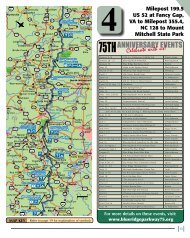Blue Ridge Park way - Massanutten Resort
Blue Ridge Park way - Massanutten Resort
Blue Ridge Park way - Massanutten Resort
You also want an ePaper? Increase the reach of your titles
YUMPU automatically turns print PDFs into web optimized ePapers that Google loves.
Just<br />
for<br />
KIDS<br />
YOUTH IN THE<br />
GREAT OUTDOORS<br />
The Department of the Interior’s Youth in the Great Outdoors<br />
Initiative helps achieve the vital goal of connecting young<br />
people with America’s natural and cultural heritage. By educating,<br />
engaging, and employing youth, we will help tackle<br />
some of the many challenges facing young people today, from<br />
high unemployment rates to declining health. Reconnect with<br />
our natural and cultural heritage while building personal experiences<br />
that can be the foundation of careers in resource stewardship.<br />
It is fun and rewarding! Find more at www.americasgreatoutdoors.gov<br />
or www.youthgo.gov including links to the<br />
“Track Trails” program of the <strong>Blue</strong> <strong>Ridge</strong> <strong>Park</strong><strong>way</strong> Foundation.<br />
RANGER LED PROGRAMS<br />
Rangers and park volunteers share their knowledge of the<br />
<strong>Park</strong><strong>way</strong> by presenting a variety of interpretive programs from<br />
June through October. Campfire talks, guided hikes, historic<br />
craft demonstrations, music, and nature study are some of the<br />
activities you and your family can enjoy. Specific schedules are<br />
posted at all developed areas.<br />
JUNIOR RANGER PROGRAMS<br />
A Junior Ranger is someone like you who cares for and learns<br />
about America’s national parks so that others in the future may<br />
enjoy them. Ask for a handbook at any visitor center and begin<br />
your journey to becoming a <strong>Park</strong><strong>way</strong> Junior Ranger.<br />
PARKS AS CLASSROOMS<br />
<strong>Blue</strong> <strong>Ridge</strong> <strong>Park</strong><strong>way</strong> staff offers programs for students in their<br />
classrooms during the school year. The aim is to connect students<br />
with the natural world and the region’s cultural heritage in<br />
<strong>way</strong>s that are real and meaningful, while meeting state curriculum<br />
standards. In the spring and fall, Rangers offer programs<br />
at many locations along the <strong>Park</strong><strong>way</strong>. Teachers should contact<br />
the closest <strong>Park</strong><strong>way</strong> office from the list provided in the “FOR<br />
TEACHERS” section of www.nps.gov/blri. The best hope for the<br />
future lies in educating today’s children!<br />
www.nps.gov/blri<br />
1-800-PARKWATCH (727-5928)<br />
PARKWATCH:<br />
The <strong>Park</strong>watch program encourages visitors and park neighbors<br />
to actively protect and preserve this special place.<br />
Please be alert and report any uncontrolled fires, emergencies,<br />
accidents, safety hazards, vandalism, or crime to a park<br />
employee. For general <strong>Park</strong><strong>way</strong> information, call (828) 298 0398.<br />
“MAKING A DIFFERENCE”<br />
A RESPONSIBLE VISIT<br />
The best diet for all animals is a natural one. Human food can<br />
make any wild animal sick. The digestive system of a white<br />
tail deer, common around campgrounds and picnic areas,<br />
only breaks down the natural food sources including twigs,<br />
bark, leaves, grasses and acorns. Wild animals like the taste of<br />
human food, but for their safety and health, do not feed them.<br />
The <strong>Park</strong><strong>way</strong> has unique habitats that support rare and endangered<br />
plants and animals. Many of these plants are threatened<br />
by foot traffic. The problem can be alleviated by the simple<br />
practice of staying on the trail. There are several especially<br />
sensitive areas, including the Tanawha Trail around Grandfather<br />
Mountain, the Craggy Pinnacle Trail at Craggy Gardens, and at<br />
Devil’s Courthouse. Whether you suspect the presence of rare<br />
plants or not, please stay on the trail – if for no other reason<br />
than to protect all plants and to prevent erosion.<br />
Rabies can be transmitted by most wild animals. Animals in<br />
the park should not be treated as pets or lured close enough to<br />
feed or touch. If a squirrel, chipmunk, or other animal comes<br />
close without your encouragement, it could be a sign of serious<br />
illness, please tell a ranger.<br />
All plants on the <strong>Park</strong><strong>way</strong><br />
are protected. Many of our<br />
native wildflowers in the<br />
<strong>Blue</strong> <strong>Ridge</strong> are threatened<br />
by illegal harvesting. The<br />
large, round, shiny evergreen<br />
leaves of Galax have been<br />
gathered commercially in the<br />
southern Appalachian mountains<br />
for generations for decorative<br />
uses in floral arrangements.<br />
Now harvested<br />
on a much larger scale,<br />
they are being shipped<br />
to flower shops<br />
around the world.<br />
9








